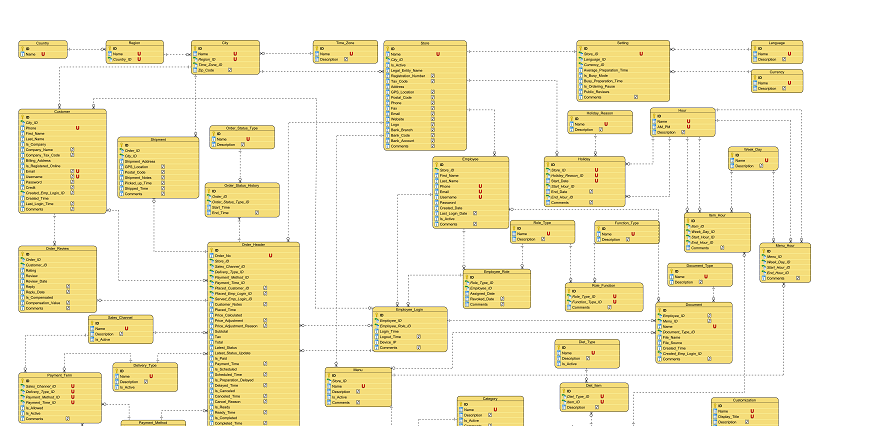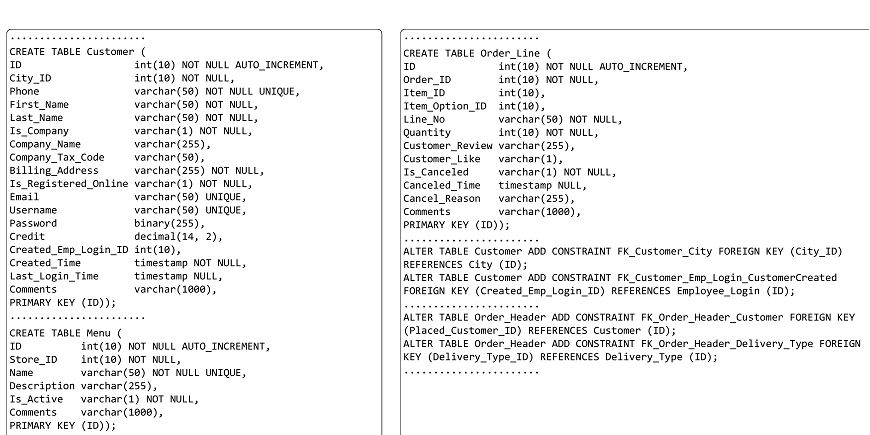Data Model Pack | Help Docs | Installation
Installation guide
Data model installation
Each data model is delivered as a .ZIP archive, known as a Data Model Pack. To begin, simply download and install it. The installation steps and requirements are the same for all data models.
Download
D/01
Demo edition download steps
- Go to Data Models page.
- Navigate to the data model you want to download the Demo edition.
- Push the Data Model button.
- Your data model overview page opens. Navigate to the SQL scripts section.
- Push the Download the demo SQL scripts button to download your demo copy of the data model.
- Extract the files from the demo .ZIP archive.
- Read carefully the Demo edition terms of use.
D/02
Licensed editions download steps
- Go to Data Models page.
- Navigate to the data model you want to download the Licensed edition.
- Push the Data Model button.
- Your data model overview page opens. Navigate to the Purchase section.
- Push the Purchase now button.
- Your data model Purchase page opens. Read carefully the License Agreement and the price details.
- Push the Buy button to purchase and download your licensed copy of the data model.
- Extract the files from the .ZIP archive.
Learn more about Data Model Pack editions.
SQL scripts deployment
Deployment/01
You can run the pre-built SQL scripts directly into your database to create the schema objects
or
Deployment/02
You can import the pre-built SQL scripts into any database design tool that can generate ER Diagrams and database schema from SQL DDL files.
Deployment/01
Run the pre-built SQL scripts directly into your database
Create database schema objects
You need a database instance up and running and a database admin account to deploy the SQL scripts into the database.
- Create a new empty database schema. For example the SQL command to create a new empty database schema in MySQL is: create schema 'schema-name';
- Open your SQL management console and connect to the new database schema.
- Open the [data-model-name]-MySQL-Create.ddl file in your SQL management console.
- Run the [data-model-name]-MySQL-Create.ddl file to create the data model objects in the database schema.
Delete database schema objects
If you need to delete the database schema objects:
- Open your SQL management console and connect to the new database schema.
- Open the [data-model-name]-MySQL-Drop.ddl file in your SQL management console.
- Run the [data-model-name]-MySQL-Drop.ddl file to drop all the data model objects from the database schema.
Follow similar steps to create the database schema objects for all supported database engines: MS SQL Server, Oracle, PostgreSQL, Sybase SQL Anywhere and more.
Your licensed copy of the .ZIP archive contains specific Create / Drop SQL scripts for all these databases:
[data-model-name]-MS-SQL-Server-Create.ddl
[data-model-name]-MS-SQL-Server-Drop.ddl
[data-model-name]-Oracle-Create.ddl
[data-model-name]-Oracle-Drop.ddl
[data-model-name]-PostgreSQL-Create.ddl
[data-model-name]-PostgreSQL-Drop.ddl
[data-model-name]-Sybase-SQL-Anywhere-Create.ddl
[data-model-name]-Sybase-SQL-Anywhere-Drop.ddl
Deployment/02
Import the pre-built SQL scripts into any database design tool
You can import the pre-built SQL scripts into any database design tool that can generate ER Diagrams and database schema from SQL DDL files. Example of database design tools with this capability: erwin Data Modeler, Visual Paradigm, Sparx Systems Enterprise Architect etc
License Agreement
Please read carefully the License Agreement before starting to use any of the Data Model Pack editions. The License Agreement is a legal agreement between You (an individual person or the company you represent) as the Licensee of the Software and Data Model Pack as the Owner and Licensor of the Software. The Software means the computer software, associated documentation and any materials made available by Data Model Pack.
Data Quality
Built to ensure data quality
Data Model Pack started from the wish to share the knowledge and the lessons learned from many database design projects. We focus on keeping the data models close to business use cases and flexible enough to anticipate new business requirements. We follow the best practices in database design to ensure data quality and to enable easy customization for future applications.

D/01
Database design best practices
We are implementing the best practices in database design through well-thought constraints definitions: PK, FK, NOT NULL, etc. All these directly contribute to ensure the overall data quality for the new applications that will use the database schema.
D/02
Flexible rules for database logic
We have built the data models starting from the idea to make the database schema flexible and customizable. Whenever possible, we have created dimension tables that store what we call list of values: Sales_Channels, Delivery_Type, Discount_Type, Payment_Method etc.
Support
We are here to help
We'll support you throughout the evaluation, purchase and maintenance of our data models. We offer use cases, detailed documentation and technical support.

S/01
Help Center
If you are looking for Frequently Asked Questions, Help Docs or to get in touch with support, you can visit our Help Center.
S/02
Help Docs
You can learn from our detailed documentation about the features and technical design of each data model and how to achieve your specific objectives with Data Model Pack.
Get started
Discover Data Model Pack benefits
Data Model Pack helps you to move forward with well-thought industry data models. Get started and discover all the benefits Data Model Pack offers.


- √Clear and flexible data models
- √Instant data model to database schema deployment
- √Entity Relationship Diagrams definition
- √Tables and columns detailed documentation
- √Database design best practices implementation
- √Cost-effective data strategy for applications
Accelerate every database schema design with powerful data models
We have already created the database diagram and prepared SQL scripts to deploy your database schema.
© 2025 Data Model Pack · Terms of Use · Privacy
